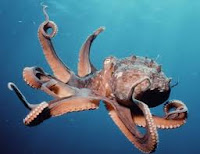Phylum :- Mollusca
Characters :-
(ii) Presence of a protective external dorsal shell. In some cases, it may be internal & covered by tissue or secondary reduced or lost.
(iii)A visceral mass remains enclosed by a thick muscular fold of the body wall called mantle.
(iv)Body monomeric & highly variable, essentially with an anterior head bearing eyes & sensory tentacles, a large ventral foot & posterior mantle cavity.
Class :- Aplacophora
Characters :-
(i) Worm like mollusca, body covered by cuticle, absence of shell.
(ii) Foot absent or reduced to a ventral ridge.
(iii) Head poorly marked & without eyes or sensory tentacles.
(iv) There are no excretory organs.
Examples:- Chaetoderma; Neomenia; Proneomenia;
 |
| Fig :- Chaetoderma |
 |
| Fig :- Neomenia |
Class :- Polyplacophora
Characters :-
(ii) A broad muscular creeping foot is present on the ventral surface.
(iii) Head is poorly developed. Eyes & tentacles is absent.
(iv) Radula is large & bears many teeth.
Examples:- Chiton; Chaetopleura; Loricata;
 |
| Fig :- Chiton |
 |
| Fig :- Loricata |
Class :- Monoplacophora
Characters :-
(ii) On the ventral side is a weakly muscular, circular foot surrounded laterally & posteriorly by an extensive mantle cavity.
(iii) Head distinct but poorly developed & without sensory tentacles.
Examples:- Neopilina; Monoplacophorus;
 |
| Fig :- neopilina |
 |
| Fig :- Monoplacophorus |
Class :- Gastropoda
Characters :-
(ii) Shell is one piece & asymmetrically spiraled.
(iii) A muscular foot is present below the digestive system & visceral mass.
(iv) Head distinct with one or two pairs of tentacles & eyes. In the digestive system, buccal contain a scrapping radula.
Examples:- Pila; Patella; Aplysia; Achatina; Helix; Lymnaea; Limax; Doris; Murex;
 |
| Fig :- Aplysia |
 |
| Fig :- Pila |
Class :- Bivalvia
Characters :-
(ii) Head indistinct & a radula is absent.
(iii) Mouth provided with two pairs of labial palps.
(iv) Relatively sedentary or even sessile.
Examples:- Mytilus; Pinctada; Lamellidens;
 |
| Fig :- Mytilus |
 |
| Fig :- Picntada maxila |
Class :- Scaphopoda
Characters :-
(ii) The elongated body completely enclosed by the mantle.
(iii) The small proboscis like head lacks & sensory tentacles.
Example:- Dentalium;
 |
| Fig :- Dentalium |
Class :- Cephalopoda
Characters :-
(ii) Shell absent or reduced & covered by the mantle in most species.
(iii) This group has a well formed head bearing large eyes.
(iv) Mouth possesses radula & jaws.
Examples:- Sepia; Loligo; Octopus;
 |
| Fig :- Octopus |
 |
| Fig :- Loligo |



This comment has been removed by the author.
ReplyDeleteClasses are present but subclasses are not present
ReplyDelete